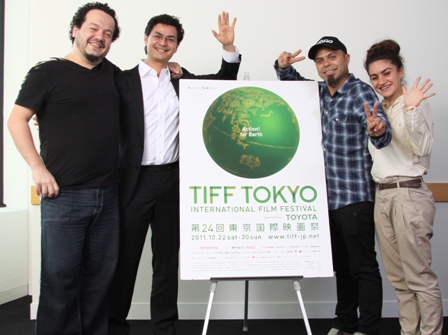Competition “The Compass is Carried by the Dead Man”
interview with Arturo Pons (Director), Ozcar Ramirez Gonzalez (Producer) and Edgar Barroso (Music)

(To the left:Ozcar Ramirez Gonzalez(Producer), Edgar Barroso(Music), Arturo Pons(Director), Anna Ribera(Costume))
“The Compass is Carried by the Dead Man” is an absurdist parable about a group of Mexicans trying to cross the border between Mexico and the United States, only ending up going in circles. I sat down with Arturo Pons, the director – affectionately known as Chango – his producer Ozcar Ramirez and Chango’s long-time friend, collaborator and music composer for the film, Edgar Barroso.
— Why this story about the border?
Arturo Pons: I don’t know. It just came to me. I was studying and every day we had homework. We had to write a script for a short film – every day. So I had, like, too many short film scripts. And this one of them, until sequence twelve, I think, and it’s a real story that happened to some friends of mine in Mexico. So when I went to my teacher, Michel Gaztambide, who was the scriptwriter of Julio Medem’s “Vacas” ― which won here in 1992―he told me, “You have to go on with this. Why don’t you go on with this story.” So then I decided to make it less real, more unreal, more fantastic maybe. I took this theme, the disorientation theme―that’s the thing that rules every character, in every sequence, in every shot, everything in the movie. It’s not that I felt disoriented. It’s because I feel the world and the society and a lot of communities have this feeling. So, I decided to start developing the script that way. That was in 2004 when I started writing. And then a few years later, it seems prophetic because… at that time in my country it was much more different than now. Now there’s a war. Soldiers are killing each other and killing everybody and the government has no compass.

— Are you talking about the narco-traficantes and what’s going on now?
Pons: Yes, but not at that time. But we took it seriously while we were shooting because we shot it two years ago and was like a big responsibility. Because we had that story at that time and when we were shooting things had changed. It was like a responsibility, so we decided to make it this way.
— And so…
Pons: Living in Barcelona, I evoked all the images, the characters that are in the wagon. I think it’s easier to evoke all these images being outside Mexico, because if you’re in Mexico, you watch all these images every day. But you can make a compilation if you’re outside and decide what works and what doesn’t work and start building… making the meaning of each image and each character. I think it’s easier. It’s like what Buñuel did in Mexico with “Viridiana.” And there are many directors and screenwriters and even writers that are outside of their countries. I think it’s a plus if you can do that.
— Like Arturo Bolaño.
Pons: And Julio Cortázar. He wrote almost all of his work in Paris, speaking about Argentina. It’s rich and it’s great. I think it’s a plus.
— So that inspires you to be away from Mexico?
Pons: Well I was there and I had to take advantage of it. And I think I took a lot from it.
— In this film the influence of Buñuel is huge. Could you talk about the similarities and the differences between you and Buñuel?
Pons: We can talk a lot about the similarities, like he was from Calanda, a town that is famous because everyone in the town plays drums. You can read about in his memoir. And I’m a drummer. Rock and roll! There’s that simple similarity, but I don’t think I’m into surrealism. There are a lot of people who say I’m making magic realism. But I think with magic realism they only talk about Latin American writers, but I think the spirit that makes this kind of thing is worldwide. For example (Hayao) Miyazaki has it. The creative process that leads you to have these kind of works. El espiritu que tu lleva que consiges este tipo de trabajo (The spirit that leads you is what makes you accomplish this kind of work). So there are creative people all over the world that use this creative process. I don’t like to say it’s surrealist or magic realism or anything. It’s just the creative process that leads you there. It’s not Jodorowsky either or it’s not David Lynch. Every one of us, we have our own creative process. We have a lot of things in common, but I don’t know Breton, so I’m not surrealist. I didn’t sign Breton’s booklet, you know. Yeah, I mean, that’s too standard. They try to standardize you in that way. I’m just making my movie and I’m trying to make it fun, for example. For example, nobody compares the compass with Tati, but it has more in common with “My Uncle” in how do I treat space than with Buñuel. I mean I have a lot of film references in here. And I love to study cinema. I have a lot of references, but it’s always like Buñuel and Jodorosky. Even Miyazaki or Yasujiro Ozu. He’s a big influence. There’s a lot of Yasujiro Ozu in this movie, but it’s not obvious.
— I think there’s a bit of “The Exterminating Angel, where they enter the room two or three times. There’s repetition…”
Pons: Exactly!
— And then like in “Viridiana” where they pose like the Last Supper and where you do Gericault’s Raft of the Medusa.
Pons: No, I think it’s clear.
— And that to me is very much like Buñuel.
Pons: And also I think this is a romantic image. I mean, the 19th century romantic pictures in France. So I took the wagon, it’s a romantic element, in the way of the people, the town, el pueblo. It represents the people, but it’s not socialism. It’s romanticism. You know what I mean? And Gericault was romantic. And I took this image… there are more similarities with Gericault’s than with “Viridiana” maybe.
— But for example, Gericault, a romantic―his picture became political.
Pons: Yeah. Exactly! It was censored for a long time.
— So, do you have some political aspirations with your film?
Pons: I wrote the first sketch of the script in 2004 and in 2009 when we were shooting and the reality changed a lot. And just in the way that reality has become more similar to the movie, not the movie to the reality. You know what I mean? When we were shooting we had this responsibility. Because we said, now the reality has changed. And the picture is more similar to reality. There’s this similarity, so now we’re on the wagon and there’s a criticism about many things.
Edgar Barroso: Can I add something that Chango mentioned in previous interviews? I think what is really interesting about the movie is that it does represent a lot of the problems that Mexico is having now. Like drugs, military people among civilians, poverty, isolation and so on. And yet, he only puts them there so people can interpret whatever they want and go deeper as they want to go. Because many movies right now, many directors now are touching these subjects so much about violence and stuff. And I think Chango didn’t want to make another movie about migration and drugs and stuff like that. But at the same time he used humor to actually put those things there more for an act of reflection and not so much as a proactive thing. He doesn’t have a posture about anything. It’s not satire.

Pons: It’s a way to make things. A process
Barroso: On thing that’s very common in Mexican culture is that you approach problems through humor. We laugh about pretty much anything, even death. Let’s talk about a dead guy, that’s beginning to smell in a wagon.
Pons: It’s like there are too many readings of the movie. I’m not the one that’s going to impose the readings. That’s the rich thing about movies. And you can read a lot of things in them. Looking at “Last Year in Marienbad” you can imagine whatever you want. It’s like “Rayuela” by Cortázar, you can make your own idea of the film, so that’s what I wanted to do. And I think I got it. I am already now having a lot of readings, different readings. It’s very interesting because the feedback it’s like more interesting now. It’s still alive, you know? It’s very very interesting and I’m so exited about that.
— I think, again, the reading of the film, kind of like Buñuel, is that you have images, you have types of people, you have situations that are somewhere between symbolic and absurd. The symbolism is not hitting you on the head.
Pons: For example here’s an anecdote. Marco Perez, the actor who plays Rogelio, the goatherd. One day he came to me during shooting. “Tell me what did you mean with this dog? You know the dog that’s following us.” And I said, “Well, when I was younger I had a dog.”
Barroso: I knew that dog!
Pons: It was a dog that fell from a window and he broke his leg. It was very funny how she moved, like (imitates a loose, broken limb with his arm). It was funny. A funny image. So I said, “Well, it’s a funny image.” You know. One-eyed kid, electric shocks, you know… And he was like… he had an entire interpretation of it. It was like, if you want to, why not? Because we played a lot with the “why not” thing, as Ozcar can tell you about it. At first it was like a problem, but then it was like “why don’t we make a shot this way.” And he said, “Well, you better do it…” And I always said, “Well, why not, why not? We’re pretending to make a film, a personal film. So, why not this way?” So we got this film, as you’ve seen. We got this 360-degree shot and too many things. If you watch it shot by shot you’ll see this “why not” thing. Ozcar can tell you more.
Ozcar Ramirez Gonzalez: What Chango is telling you is how the process was built based on freedom. He’s the most free [director] in my life I’ve ever worked with, ever produced. Every time Chango would come with crazy ideas. Because we had the script – and the script was crazy enough – but then he would come and say, “I have this incredible idea. Why don’t we do this thing?” And it’s completely… I just don’t get it. I always said, like, “OK. What do you want to say with this? What is the meaning of this? Why do you want to…?” And he would always answer, “Why not?” That was the explanation. Why not? And then would say, “Why not?” then go and do it and no problem.

Pons: He was very worried. At that time
Gonzalez: I’ll tell you this story. I think you’ll find it very funny. When we were shooting the film… we worked for three years, trying to understand what he was trying to do and getting the money. But when we were doing the shooting, I had to travel. I just went to the first day of the shooting. The second day I traveled to Amsterdam because I was presenting a documentary I made – there. So I had to go. So, I asked the assistant editor to send me all the rushes of the film, so I could see it. The first day I received, like, 8 minutes, which is such a small amount of time for the first day. So I called her and said, “You only sent me one camera roll, so send me the rest.” And she said, “No, this is all.” And I freaked out. “What do you mean this is all?” “Yeah, this is all that they shot.” “But there are no close-ups. There is one scene that he shot only once.” And she said “Yeah, but he liked it.” “What do you mean, he liked it?” You have to shoot these scenes several times. Then I called him very worried, like “Chango, you need to shoot everything. I bought a lot of…”
Pons: “You need to shoot more!”
Gonzalez: That was the phrase. OK. So I said, “I bought a lot of film for you. Use it. It’s there. Don’t worry. Go and shoot more.” And he was saying, “No, no, take it easy. I don’t need more.” Next day, I received two camera rolls. And I’m freaking out. My God, this film is not gonna… you know we’re not gonna be able to edit it. And I insist. And I insist and I receive an email from him saying, “Ozcar, today I did what you told me and shot a lot more. So check the material.” And when I saw the material – I received two camera rolls of the film ―and then I reviewed two camera rolls where he shot himself doing tricks on the skateboard.
Pons: In slow motion.
Gonzalez: He wanted the crew to show himself doing tricks in slow motion. And then I thought like, OK, I will relax. I will trust him. I will let him do whatever he wants. But his way to tell me to relax is “today I shoot a lot of material. Take a look at it.” And I see him doing tricks that have nothing to do with the film. So, this is the kind of relationship that we started, like… let’s let it go. So I relaxed and said, “I trust you.” So now we have this film and I feel so proud of it.
Interviewed by Nicholas Vroman (Film writer)
The Compass is Carried by the Dead Man












